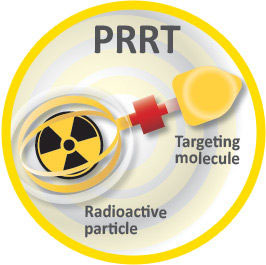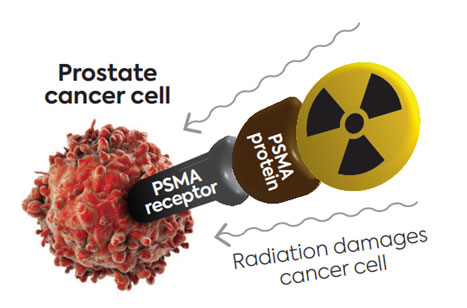Targeted Radionuclide Therapy
Targeted radionuclide therapy involves a radioactive drug called a radiopharmaceutical that targets cancer cells.
Peptide Receptor Radionuclide Therapy (PRRT)

PRRT is used to treat a specific type of cancer called neuroendocrine tumors or NETs.
In PRRT, a cell-targeting protein (or peptide) is combined with a small amount of radioactive material, (or radionuclide), creating a special type of radiopharmaceutical called a radiopeptide. Yttrium 90 (Y-90) and Lutetium 177 (Lu-77) are the most common used radionuclides.
When injected into the patient’s bloodstream, this radiopeptide travels to and binds to neuroendocrine tumor cells, delivering a targeted high dose of radiation directly to the cancer cells, while reducing harm to healthy tissues.
Each PRRT session begins with the appropriate anti-nausea pre-medications, followed by an amino acid solution. The amino acid solution is delivered intravenously to protect the patient’s kidneys from the effects of the treatment. After 30 minutes, the PRRT drug will be given by slow intravenous injection. Then, the amino acid drip will be continued for another 3½ hours and the treatment is complete.
The PRRT drug emits beta radiation that treats the cancer, as well as gamma radiation that can be seen in a SPECT/CT scanner. Post-therapy scan may be taken following the treatment process to image the drug location and disease condition.
PRRT is considered a targeted therapy because radiopeptides are highly selective in their ability to specifically reach and damage neuroendocrine tumor cells, while limiting radiation exposure to healthy tissue. As a result, PRRT typically is well tolerated. PRRT is a treatment option that is highly effective in controlling advanced, metastatic or inoperable, progressive neuroendocrine tumors with positive GA68-DOTATATE PET/CT scan.
Lutetium-177 PSMA Therapy

Lu177-PSMA therapy is a type of molecular therapy that is used to treat metastatic prostate cancer.
Lutetium-177 is a radionuclide substance that emits damaging radiation which will destroy cancer cells. It is combined with PSMA protein that seeks out PSMA receptors which are found on majority of prostate cancer cell surface. Once Lutetium-177 PSMA is infused into a patient’s bloodstream, it will target and bind to PSMA receptors on prostate cancer cells. Damaging radiation from the Lutetium-177 will, over time, result in death of the prostate cancer cells.
Before commencing treatment, patients will need to undergo a PSMA PET-CT scan to confirm PSMA receptors on the cancer cells, which will be targeted by Lutetium-177 PSMA. Treatment can be done as outpatient and hospitalization is not required. The Lu177-PSMA drug will be given by slow intravenous injection. The drug administration process will take around 1 hour to complete.
The Lu177 drug emits beta radiation that treats the cancer, as well as gamma radiation that can
be seen in a SPECT/CT scanner. The next day (24 hours) after Lu177-PSMA treatment is given, every patient will undergo a post therapy scan to image the drug location and disease condition.
